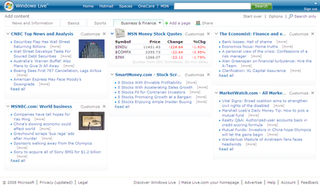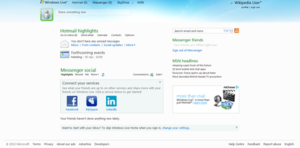Trillian is a proprietary multiprotocol instant messaging application created by Cerulean Studios. It is currently available for Microsoft Windows, Mac OS X, Linux, Android, iOS, BlackBerry OS, and the Web. It can connect to multiple IM services, such as AIM, Bonjour, Facebook Messenger, Google Talk (Hangouts), IRC, XMPP (Jabber), VZ, and Yahoo! Messenger networks; as well as social networking sites, such as Facebook, Foursquare, LinkedIn, and Twitter; and email services, such as POP3 and IMAP.
Messenger was an instant messaging and presence system developed by Microsoft in 1999 for use with its MSN Messenger software. It was used by instant messaging clients including Windows 8, Windows Live Messenger, Microsoft Messenger for Mac, Outlook.com and Xbox Live. Third-party clients also connected to the service. It communicated using the Microsoft Notification Protocol, a proprietary instant messaging protocol. The service allowed anyone with a Microsoft account to sign in and communicate in real time with other people who were signed in as well.

Microsoft Outlook is a personal information manager software system from Microsoft, available as a part of the Microsoft Office suite. Though primarily an email client, Outlook also includes such functions as calendaring, task managing, contact managing, note-taking, journal logging, and web browsing.

MSN is a web portal and related collection of Internet services and apps for Windows and mobile devices, provided by Microsoft and launched on August 24, 1995, the same release date as Windows 95.

Outlook on the web is a personal information manager web app from Microsoft. It is included in Microsoft 365, Office 365, Exchange Server 2016/2019, and Exchange Online. It includes a web-based email client, a calendar tool, a contact manager, and a task manager. It also includes add-in integration, Skype on the web, and alerts as well as unified themes that span across all the web apps. Outlook on the web is navigated using the App Launcher icon which brings down a list of web apps from which the user may choose. In 2015, Microsoft started upgrading Outlook.com and Outlook on the web to use the Office 365 infrastructure, which was almost complete in January 2017 after the next version of Outlook.com was released.
Microsoft Notification Protocol is an instant messaging protocol developed by Microsoft for use by the Microsoft Messenger service and the instant messaging clients that connect to it, such as Skype since 2014, and the earlier Windows Live Messenger, MSN Messenger, Windows Messenger, and Microsoft Messenger for Mac. Third-party clients such as Pidgin and Trillian can also communicate using the protocol. MSNP was first used in a publicly available product with the first release of MSN Messenger in 1999.

Windows Live is a discontinued brand-name for a set of web services and software products from Microsoft as part of its software plus services platform. Chief components under the brand name included web services, several computer programs that interact with the services, and specialized web services for mobile devices.

Windows Live Personalized Experience was a customizable portal launched by Microsoft in early November 2005. It was one of the first Windows Live services to launch.
Push email is an email system that provides an always-on capability, in which new email is actively transferred (pushed) as it arrives by the mail delivery agent (MDA) to the mail user agent (MUA), also called the email client. Email clients include smartphones and, less strictly, IMAP personal computer mail applications.

Windows Essentials is a discontinued suite of Microsoft freeware applications that includes email, instant messaging, photo sharing, blogging, and parental control software. Essentials programs are designed to integrate well with each other, with Microsoft Windows, and other Microsoft web-based services such as OneDrive and Outlook.com.

Windows Live Alerts was a part of the Windows Live services from Microsoft that allowed users to get notification of time-sensitive events and information from various alert content providers. Users were able to choose how and when to receive alerts, so that users may stay informed no matter where they are.

The Helio Ocean was a dual slider Internet-enabled multimedia wireless mobile device sold by mobile virtual network operator (MVNO) wireless carrier Helio, and manufactured by Pantech Curitel. A distinctive design feature of the Ocean was its dual sliding mechanism — when slid down in the vertical position, it revealed a telephone keypad. When slid down in the horizontal position, it revealed a 35-key QWERTY keyboard.

Windows Live Web Messenger was the browser-based version of Windows Live Messenger developed by Microsoft which allowed users to send instant messages online and in real-time with others using the Microsoft Messenger service from within a web browser. The service allowed users without administrative privileges on their computer, such as at a shared public computer, to chat with others on their Messenger contact list without having to install the Windows Live Messenger client.

Windows Live Mail was a freeware email client from Microsoft. It is the successor to Windows Mail in Windows Vista, which was the successor to Outlook Express in Windows XP and Windows 98. Windows Live Mail is designed to run on Windows 7 and Windows Server 2008 R2, but is also compatible with Windows 8 and Windows 10, even though Microsoft bundles a new email client, named Windows Mail, with the latter.

Outlook.com is a personal information manager web app from Microsoft consisting of webmail, calendaring, contacts, and tasks services. Founded in 1996 by Sabeer Bhatia and Jack Smith, Hotmail was acquired by Microsoft in 1997 for an estimated $400 million and relaunched as MSN Hotmail, later rebranded to Windows Live Hotmail as part of the Windows Live suite of products. Microsoft phased out Hotmail in October 2011, relaunching the service as Outlook.com in 2012.

MSN Messenger, later rebranded as Windows Live Messenger, was a cross-platform instant messaging client developed by Microsoft. It connected to the Microsoft Messenger service while also having compatibility with Yahoo! Messenger and Facebook Messenger. The client was first released as MSN Messenger Service on July 22, 1999, and was marketed under the MSN branding until 2005 when it was rebranded under Windows Live. It has since been officially known by its second name, although its first name was still used colloquially by most of its users. In June 2009, Microsoft reported the service attracted over 330 million active users each month, placing Messenger among the most widely used instant messaging clients in the world.

A Microsoft account or MSA is a single sign-on Microsoft user account for Microsoft customers to log in to Microsoft services, devices running on one of Microsoft's current operating systems, and Microsoft application software.

MSN Dial-up is an Internet service provider operated by Microsoft in the United States and formerly also in several other countries. Originally named The Microsoft Network, it debuted as a proprietary online service on August 24, 1995, to coincide with the release of Windows 95. In 1996 and 1997, a revised web-based version of the ISP was an early experiment at interactive multimedia content on the Internet.

People is a contact management app and address book included in Microsoft's Windows 8 and 10. It allows a user to organize and link contacts from different email accounts. People has a unique graphical interface, unlike Windows Contacts' File Explorer-based interface, based on the Metro design language that had already been used for Outlook.com and the integrated online People service. In addition to being an address book, it provides a list of recent mail conversations with a selected contact. It used to also be a social media hub, in which users could integrate their social networking accounts, but API changes in both Windows and social media services caused this functionality to break.















